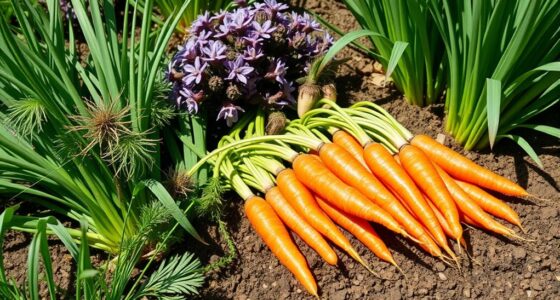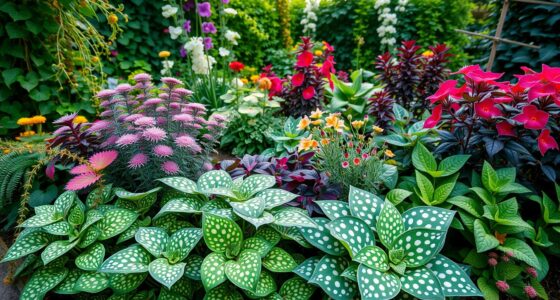Imagine stepping into your garden, the sun warming your skin, and the vibrant colors of your plants catching your eye. Among the lush greenery, the tomato plants stand tall, their juicy promise tantalizing your taste buds. Tomatoes have a special place in many of our hearts and kitchens, providing the base for countless meals. But did you know that there’s a simple way to maximize their growth and flavor? By understanding and utilizing the power of companion plants for tomatoes, you can elevate your gardening game. This tomato companion planting guide will take you through the plethora of benefits that occur when you grow these plants side by side, creating a thriving ecosystem in your garden.
Key Takeaways
- Companion planting enhances tomato growth and yields.
- Specific plants help deter pests naturally.
- Integrating diverse plants improves soil health.
- Flavorful companions can enhance the taste of your tomatoes.
- Planning layout and spacing is important for optimal growth.
Why Companion Planting Matters for Tomatoes
Companion planting with tomatoes offers a multitude of benefits, essential for cultivating a flourishing garden. By selecting beneficial plants for tomatoes, you create a thriving ecosystem that promotes better growth and resilience. Organic companion plants for tomatoes not only enhance soil structure but also offer natural pest control solutions while improving the overall flavor of your harvest.
Promotes Healthy Growth
Integrating organic companion plants for tomatoes can significantly improve their growth. These plants provide vital nutrients to the soil and support healthy root systems. Some options, like legumes, enhance nitrogen levels, enabling your tomatoes to thrive. A diverse plant community contributes to a rich micro-environment, allowing tomatoes to flourish.
Reduces Pests
Companion planting with tomatoes can effectively reduce pest populations. Certain companions, such as marigolds and basil, attract beneficial insects and repel harmful pests. By fostering a natural balance, you minimize the need for chemical pesticides, ensuring a healthier garden ecosystem.
Enhances Flavor
The right companions can even enhance the flavor of your tomatoes. Herbs like basil not only pair well in the kitchen but also improve the aromatic profiles of tomatoes, contributing to a tastier yield. By choosing the proper combinations, you can enjoy flavorful produce straight from your garden.
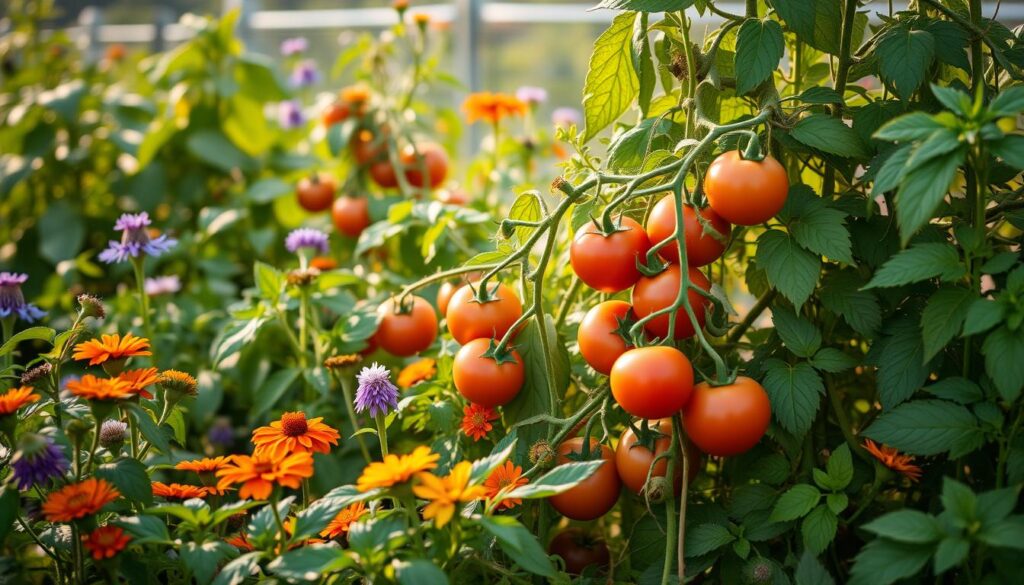
| Benefit | Description |
|---|---|
| Healthy Growth | Organic plants provide nutrients and improve soil health. |
| Pest Reduction | Beneficial plants attract helpful insects and deter pests. |
| Flavor Enhancement | Companion herbs can elevate the taste of tomatoes. |
Best Companion Plants for Tomatoes
When planning your tomato garden, choosing the right plant companions can significantly enhance your gardening experience. Several plants stand out as the best companion plants for tomatoes, offering benefits in flavor enhancement, pest control, and nutrient sharing. Here are a few noteworthy options to consider.
Basil: A Flavorful Ally
Basil isn’t just a culinary favorite; it’s also one of the most effective plant companions for tomatoes. This aromatic herb is known to potentially improve the flavor of your tomatoes while repelling challenging pests like thrips. By growing basil alongside your tomatoes, you’re setting the stage for a more fruitful harvest.
Marigolds: The Pest Deterrent
Marigolds serve as an excellent option for natural pest control for tomatoes. Their vibrant blooms attract beneficial insects while deterring harmful ones, particularly aphids and root nematodes. Planting marigolds near your tomato plants not only adds a splash of color to your garden but also creates a protective barrier against unwanted pests.
Borage: A Boost of Nutrients
Borage stands out among the best companion plants for tomatoes due to its nutrient-rich characteristics. This flowering herb effectively repels harmful insects and enhances soil fertility, making it a wonderful addition to your tomato garden. Growing borage can lead to healthier plants with a greater yield, helping to nurture your green thumb.

Herbs that Pair Well with Tomatoes
Integrating herbs into your tomato garden can enhance both the growth and flavor of your tomatoes. These companion plants for tomato garden not only provide an aromatic touch but also play a crucial role in pest management and pollination. Two standout herbs for tomatoes are oregano and chives, each offering unique benefits.
Oregano: Aromatic and Protective
Oregano thrives alongside tomatoes, attracting beneficial pollinators while repelling unwanted pests. Its fragrant flowers are a magnet for bees, helping to boost tomato yields. The herb’s essential oils act as a natural deterrent, keeping aphids and other pests at bay.
Chives: Flavor and Defense
Chives are more than just a culinary delight. Their onion-like scent can ward off pesky aphids and spider mites that threaten tomato plants. Easy to grow and maintain, chives share similar growing conditions with tomatoes, making them excellent herbs for tomatoes. Adding chives to your garden will not only accentuate your tomato dishes but also defend your plants against harmful insects.

| Herb | Benefits | Growing Conditions |
|---|---|---|
| Oregano | Attracts pollinators, repels pests | Prefers full sun, well-drained soil |
| Chives | Repels aphids and spider mites | Thrives in rich, moist soil, partial sun |
Vegetables that Benefit from Tomato Companions
When you think about intercropping with tomatoes, consider other vegetables that thrive alongside your tomato plants. Choosing the right vegetable companions for tomatoes can significantly enhance their growth and overall garden health. Below are two excellent options that make great neighbors for your tomatoes.
Peppers: A Friendly Neighborhood
Growing peppers near tomatoes often yields fantastic results. Both plants share similar water needs and thrive in comparable soil conditions, optimizing your garden space. This proximity can lead to a more robust yield from both crops, creating a vibrant, productive environment. Furthermore, peppers can benefit from the added shade provided by tomato plants, particularly during peak sunlight hours, helping them retain moisture and thrive.
Carrots: Underground Allies
Intercropping with tomatoes can also benefit from the inclusion of carrots. This root vegetable not only occupies the soil below ground, allowing for efficient use of space, but it also aerates the soil. The presence of carrot plants promotes healthier root systems for tomatoes, enhancing nutrient uptake. Additionally, tomato foliage can provide much-needed shade, protecting carrots from heat stress, further improving their growth potential.
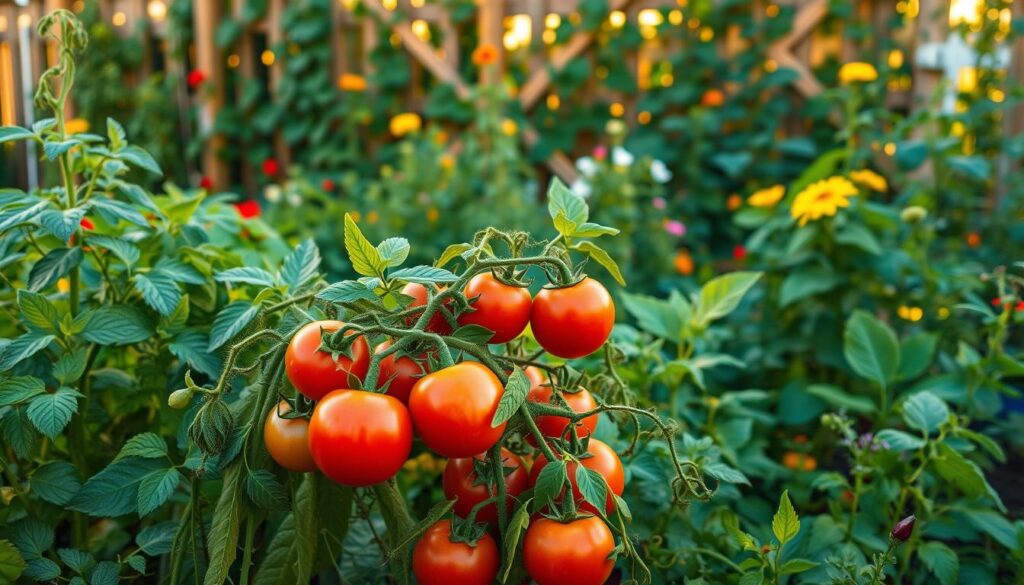
Flowers that Attract Pollinators
Flowers play a crucial role in enhancing the productivity of your tomato garden by attracting pollinators. Zinnias and sunflowers are two of the most colorful and effective flowers for tomato gardens, luring in bees and butterflies that aid in pollination. Incorporating these vibrant blooms not only supports beneficial plants for tomatoes but also adds visual appeal to your garden.
Zinnias: Vibrant and Inviting
Zinnias are not just visually stunning; they are valuable allies in your tomato garden. Their bright colors draw in a variety of pollinators, which helps increase tomato yields. These flowers thrive in sunny conditions and offer a long blooming season, ensuring continued attraction of essential pollinators throughout your growing season.
Sunflowers: Tall Guardians
Sunflowers stand tall and proud in the garden while providing a vast surface area for bees to land. These magnificent flowers serve as robust markers for pollinators, enhancing the benefits of companion planting. Their height also creates an inviting environment for nectar-loving insects, further boosting the productivity of your beneficial plants for tomatoes.

Companion Plants to Avoid with Tomatoes
When planning your tomato garden, it’s just as important to consider which plants to avoid as it is to select beneficial companions. Some crops can hinder tomato growth or attract unwanted pests. Understanding these harmful plants for tomatoes can save you frustration and disappointment down the road.
Cabbage Family: A Risky Relationship
Plants from the cabbage family, including broccoli and cauliflower, often compete for similar nutrients as tomatoes. Their growth can inhibit the overall health of your tomatoes. If you’re aiming for a thriving vegetable patch, these are pests to avoid when planting alongside your tomatoes.
Corn: Strained Neighbors
Corn can create complications for tomato plants. It attracts the corn earworm, a pest that poses a risk to both crops. Growing corn in close proximity to your tomatoes increases the likelihood of pest infestations, making it a relationship best avoided in your garden.

The Role of Soil Health in Companion Planting
Soil health plays a crucial role in growing vibrant tomatoes. By using companion planting tips, you can not only enhance the productivity of your tomatoes but also improve the overall quality of the soil. Incorporating a variety of plants in your garden creates an ecosystem that supports nutrient sharing and boosts microbial diversity.
Nutrient Sharing Benefits
Plants that have the capability to fix nitrogen, such as legumes, thrive alongside tomatoes. These nitrogen-fixing plants share essential nutrients, promoting soil health for tomatoes. When you grow these plants together, your tomatoes can benefit from enriched soil, leading to healthier and more robust growth.
Microbial Diversity
Diverse plant varieties foster a rich population of beneficial microbes in the soil. A thriving microbial community aids in breaking down organic matter, improving soil structure, and combating diseases. When you follow companion planting tips, you encourage a balanced ecosystem that boosts soil health, enhancing the vigor of your tomato plants.
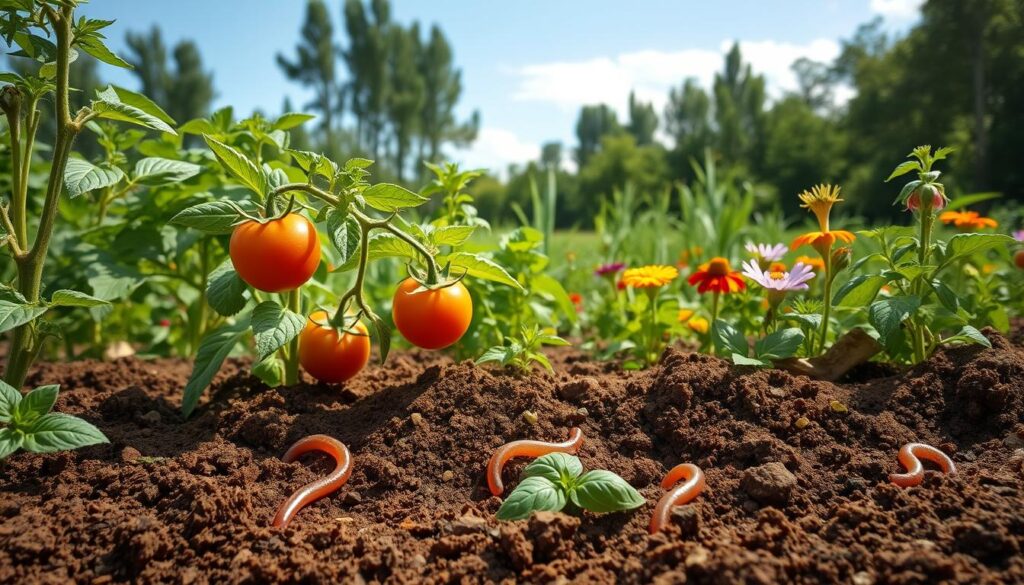
| Plant Type | Nutrient Benefits | Microbial Benefits |
|---|---|---|
| Legumes | Fixed nitrogen increases soil fertility | Supports diverse microbial life |
| Basil | Enhances flavor and health of neighboring tomatoes | Reduces harmful pathogens |
| Marigolds | Attracts beneficial insects | Suppresses harmful nematodes |
Planning Your Companion Plant Layout
Creating a successful garden layout for companion planting involves careful consideration of spacing and height. Properly planning companions for tomatoes plays a significant role in their growth and overall health. When you allocate sufficient space between plants, you promote better access to nutrients and sunlight, ultimately leading to a flourishing garden.
Spacing for Maximum Growth
Effective spacing allows each plant to thrive without overcrowding. Aim for:
- At least 18 to 24 inches between tomato plants.
- 12 to 18 inches for companion plants like basil and marigolds.
- Maintain adequate distance from taller plants to optimize sunlight exposure.
This thoughtful garden layout for companion planting enhances nutrient uptake and minimizes competition, ensuring your tomato plants remain strong and healthy.
Height Considerations
Understanding the height differences among plants is vital for creating an optimal layout. Taller plants can cast shadows on shorter ones, potentially limiting their growth. Position shorter companions like basil carefully around the tomato plants, allowing for:
- Maximized sunlight for each plant.
- Improved air circulation.
By thoroughly planning companions for tomatoes with these factors in mind, you foster a balanced garden environment that supports growth and productivity.

Seasonal Companion Planting Tips
Timing plays a crucial role in seasonal gardening for tomatoes. With careful planning, you can create combinations that not only support tomato growth but also enhance the overall garden ecosystem. Successful planting tips for tomatoes include understanding which plants to introduce during different seasons.
Spring Planting Combinations
In spring, the focus should be on quick-growing herbs and flowers. Consider combining basil with your tomatoes for its delightful flavor and pest-repelling properties. Annual flowers like marigolds can attract beneficial insects while providing added color to your garden. These combinations set a strong foundation for healthy tomato plants.
Summer Adjustments
As summer temperatures rise, adapt your planting strategy to include heat-tolerant vegetables. Introducing zucchini or eggplant alongside your tomatoes ensures that all plants benefit from a nourishing environment. Maintaining a diverse planting layout helps manage pests while promoting continued growth. Monitor your garden’s dynamics to make adjustments that favor both the tomato plants and their companions.
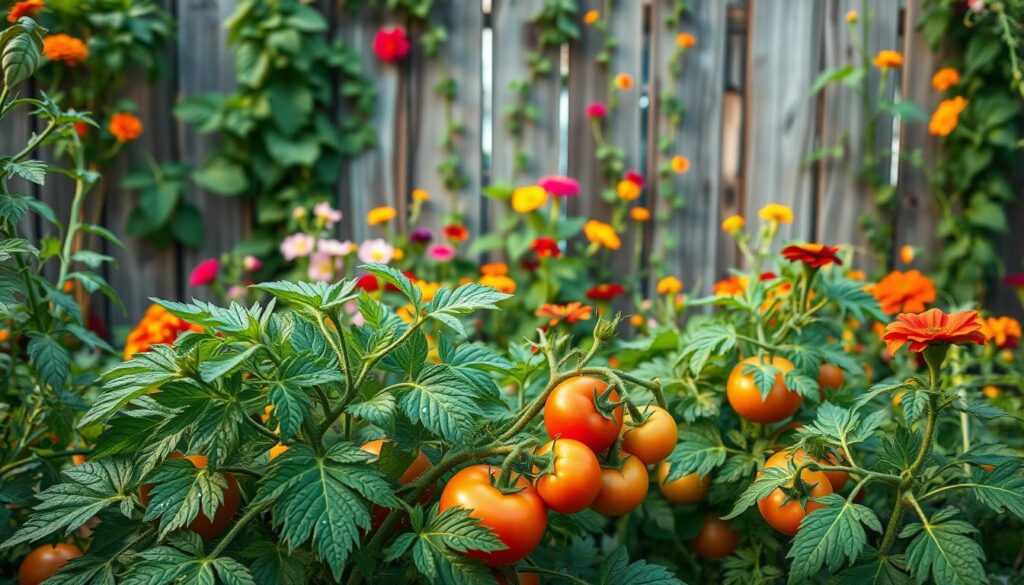
Watering and Care for Companion Plants
To ensure the success of your tomato garden, you must focus on effective watering and care tips for tomatoes. Watering tomato companions appropriately fosters a thriving environment for both your tomatoes and their companion plants. Establishing the right moisture levels will lead to vigorous growth, particularly during the early stages of plant development.
Ideal Watering Regimen
Timing and consistency are crucial in your watering routine. Aim for deep watering sessions, which encourage roots to develop deeper into the soil. A drip irrigation system can be beneficial, providing even moisture. Water your plants in the morning to reduce evaporation loss and avoid fungal diseases. Monitor your soil regularly and adjust your watering schedule based on weather conditions and the specific needs of your tomato companions.
Nutrition Needs
Understanding the nutritional requirements of your tomatoes and their companions will help establish a well-balanced growing environment. Tomatoes thrive on nutrients like nitrogen, phosphorus, and potassium. Incorporate compost or organic fertilizers to enhance soil quality. When selecting fertilizers for your watering tomato companions, choose those that offer complementary nutrients. Regularly testing soil helps identify deficiencies, guiding your approach to plant care.
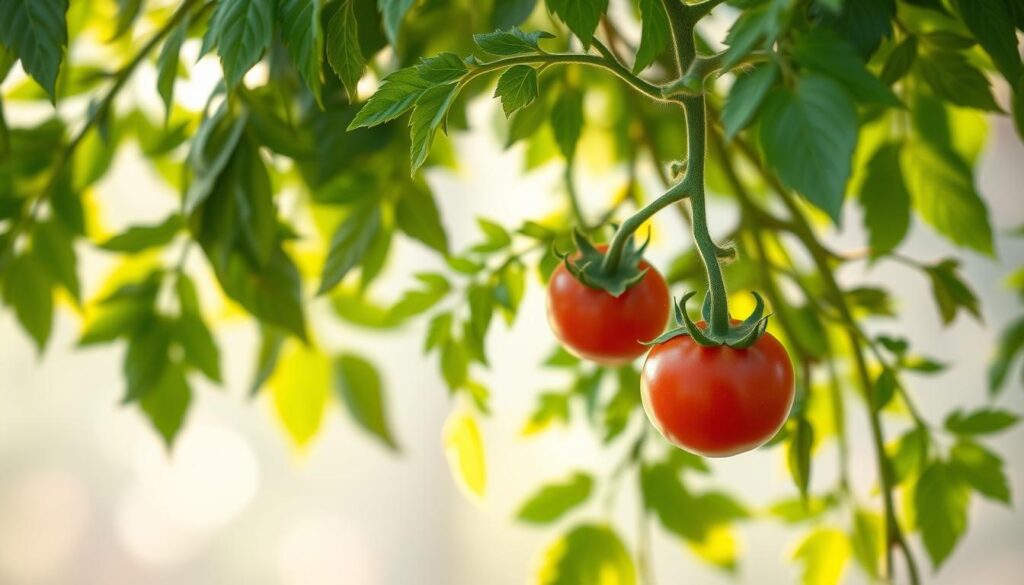
Common Pests and Their Solutions
Maintaining healthy tomato plants requires awareness of the common tomato pests that can threaten their growth and yield. Effective pest control with companion plants offers a natural approach, enhancing the resilience of these vital garden staples.
Identifying Tomato Pests
Tomato plants face various challenges from pests, including:
- Aphids: These small, sap-sucking insects can transmit diseases and weaken your plants.
- Hornworms: Known for their impressive size, these caterpillars can rapidly defoliate your plants.
- Nematodes: Microscopic worms that prey on roots, leading to stunted growth and reduced yield.
Companion Plant Solutions
Utilizing pest control with companion plants can significantly reduce the presence of these pests. Consider planting:
- Marigolds: Their scent naturally deters aphids and nematodes.
- Borage: Attracts beneficial insects that prey on common tomato pests, providing a protective shield for your plants.

Success Stories: Gardener Testimonials
Gardening enthusiasts often share fascinating experiences showcasing the impact of companion planting on their tomato crops. From increased yields to healthier plants, these success stories highlight the profound benefits of successful gardening with companion plants.
Transformative Experiences
Many gardeners describe remarkable changes after integrating companion plants into their gardening routines. One individual noted a significant transformation in their tomato plants after adding basil. This pairing not only improved flavor but also created a more vibrant garden ecosystem. You might find that testimonials on companion planting can motivate you to try new strategies that enhance your gardening experience.
Yield Improvements
Increased yields have been a common theme among those practicing companion planting. Gardeners report robust tomato harvests when utilizing the right companion plants, such as marigolds and borage. These plants work harmoniously to deter pests and enrich the soil, leading to thriving tomato plants. Exploring testimonials on companion planting can provide you with insights and strategies that could elevate your gardening success.
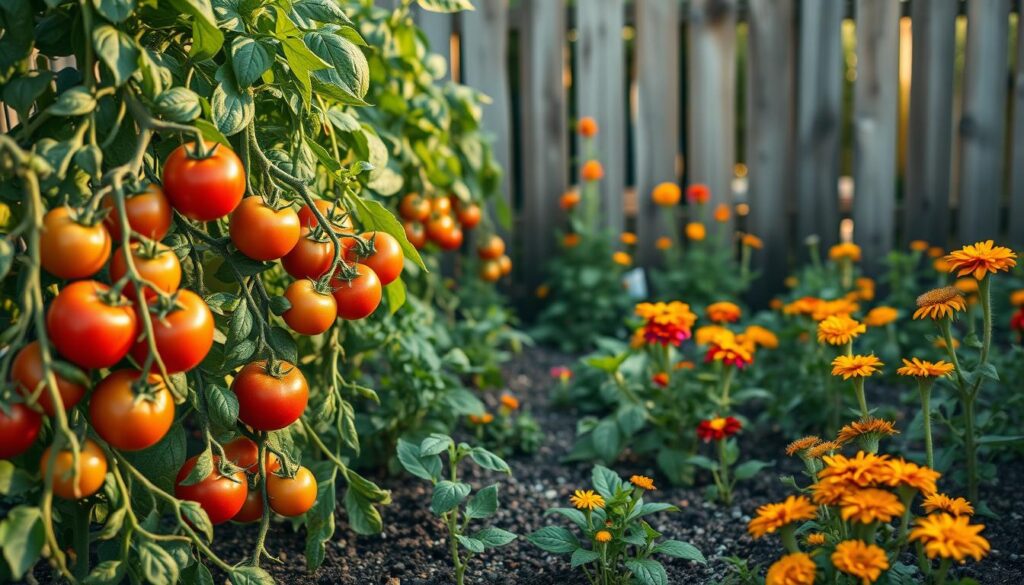
Using Companion Plants for Healthy Soil
Embracing companion planting not only enhances the growth of your tomatoes but significantly contributes to the development of healthy soil for tomatoes. By incorporating various plant species, you can boost the overall fertility of your garden soil and reap the myriad benefits of companion crops.
Building Soil Fertility
Companion plants play an essential role in adding nutrients to the soil. For example, nitrogen-fixing plants, like legumes, release nitrogen into the earth, enriching it for other crops. This natural fertilization process promotes healthy soil for tomatoes, allowing them to thrive and produce bountiful yields.
Preventing Soil Erosion
Certain companion crops, such as winter rye, contribute to soil stability by forming deep root systems. These roots help bind the soil together, reducing the risk of erosion during heavy rains or winds. Protecting the garden’s ecosystem with these plants is one of the versatile benefits of companion crops that ensures the longevity of your gardening efforts.
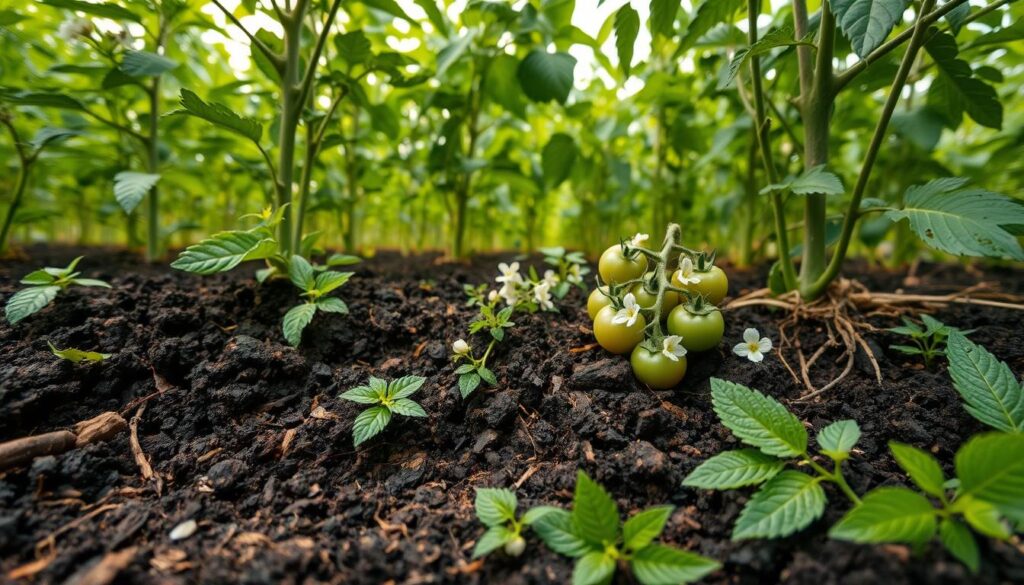
Incorporating Companion Planting into Your Garden Design
Designing your garden with companion plants not only boosts productivity but also creates an inviting atmosphere. Combining different species results in aesthetically pleasing plant arrangements that enhance visual interest. Thoughtfully integrating colors and textures can elevate your garden’s overall appeal while encouraging beneficial interactions between plants.
Aesthetic Arrangements
When planning your garden design with companion plants, consider how colors and shapes complement one another. For instance, pairing vibrant zinnias with bushy tomatoes creates a stunning contrast. You can also mix herbs like basil or chives with flowers for an elegant look. The layering of plant heights adds depth, making your space more dynamic and attractive.
Functional Design Ideas
Beyond aesthetics, functional garden design comes into play when selecting companion plants. Organizing plants by their growth habits can maximize sunlight exposure and reduce competition for nutrients. For example, taller plants can provide shade for more delicate varieties. This approach not only promotes healthy growth but also leads to a more efficient use of garden space.

Conclusion: Create Your Thriving Tomato Garden
By now, you should have a clear understanding of the numerous benefits that come from incorporating companion plants into your tomato garden. From promoting healthier growth to deterring pests and enhancing flavor, the right combinations can truly elevate your gardening experience. Embracing these insightful practices can help you cultivate a thriving tomato garden that flourishes all season long.
As you move forward with your gardening endeavors, take the time to reflect on the steps for companion planting you’ve learned. Consider experimenting with various pairings and layout designs that fit your unique gardening style. Each planting season presents an opportunity to refine your approach, ensuring that your tomatoes and their companions thrive together harmoniously.
With the knowledge gained from this guide, you are well-equipped to create your dream garden. Remember, successful companion planting not only enriches your tomato plants but also enhances your entire gardening experience. Happy planting, and enjoy the bountiful rewards that come from a well-designed companion planting strategy!


